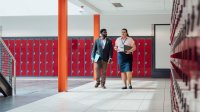Enhancing Collaboration Between Classroom Teachers and ELL Specialists
English language learners really benefit when teachers establish effective teamwork to support them.
Your content has been saved!
Go to My Saved Content.Studies have found that schools with a greater amount of teacher collaborations have resulted in higher student achievement outcomes in reading and math. Schools that have English language learners (ELLs) can especially benefit from collaborative work between classroom teachers and teachers who specialize in working with ELLs. In schools where ELLs do not have access to a specialized ELL teacher throughout their entire school day, such collaboration between adults is especially vital.
In order for this type of collaboration between teachers and specialists to work, classroom teachers must be willing to communicate—and they must also be provided with the time to do so.
Having collaborative structures in place will allow school systems to implement the following suggestions for enhancing teamwork between teachers and ELL specialists with greater ease.
Practice Early and Effective Communication
To enhance communication between teachers and specialists, make it a practice to routinely discuss methods and expectations for supporting ELL students in your classroom with all involved stakeholders—families, administrators, and ELL specialists.
Identify the accommodations that ELLs need or should be given. Some higher-level language learners may benefit from less scaffolding, for example, and most ELLs benefit from flexibility in deadlines and grading. All classroom teachers should be aware of and use the accommodations most helpful to their students, in a consistent way.
As a team, you can also educate ELL students about the accommodations they are entitled to and guide them to self-advocate for these accommodations in all of their classrooms, with the understanding that teachers across the curriculum stand ready to help them succeed.
Problem-Solve Collaboratively
As challenges arise in your classroom practice, communicate with the purpose of brainstorming methods for addressing them. If you come to solutions and think it would be helpful to share your insights with other faculty who are likely experiencing similar challenges, consider making a one-minute video together—as teacher and specialist—to offer a brief form of professional development, and share it with all teachers in your school.
Although such an approach involves extra time and work, it equips your colleagues with more knowledge of ELL-specific pedagogy—and in a personalized format—which will increase the chances of student success and spark additional conversations about ELL education among colleagues.
Educate Colleagues About Available Resources
Together, ensure that all staff and faculty know about the extra support services that students are able to receive in your learning context—including the dates and times of any available after-school help.
For example, at the high school where I teach, an algebra teacher and I collaborate to offer an extended day program for ELLs every Tuesday. Some students are reluctant to stay at school for the extra time, so I take a few minutes at the end of my day, during my prep period, to call other teachers and ask them to send students to algebra after school. I then contact guardians to ensure that they have communicated with their children about staying late for extra help.
In a few cases, I walk to the students’ classes and escort them to the extended day program, even if they stay for only 10 minutes. During the session, I provide encouragement, language support, help with study skills, and so on.
If a student is struggling in an after-school extra-help session where an ELL teacher is not available for support, the classroom teacher should know what opportunities are available to support students with these issues. In my school, we have peer tutors who volunteer to support ELLs one-on-one for community service hours, as well as a bilingual teaching assistant who works specifically with ELLs.
Whatever services you have, make faculty aware by communicating this information at faculty meetings, by email, and, if appropriate, with signage in hallways.
Help Teaching Assistants Who Work With ELLs
If you are working with a teaching assistant (TA) or student teacher, invite them to connect with the ELL specialist to consider best pedagogical practices and how they can leverage their role to support the learning of ELL students.
For example, you, along with the ELL specialist and TA, might find that having the TA as a “teacher” in your Google Classroom would help them provide extra support to ELL students, with the capability to view grades and assignment statuses or to provide individualized feedback.
Along the way, offer your TA explicit coaching about pedagogical methods, and demonstrate ways to use specific technological tools for language acquisition and translation, in alignment with recommendations from your ELL specialist.
Pursue Professional Development Together
Attend professional development workshops with your colleagues, ELL specialists, and/or teaching assistants to strengthen collaborative relationships. Research and exchange information about the cultures of the home countries of your ELL students to better attune your instructional approaches to their identities and background knowledge.
Shared professional development might also lend itself to identifying and sharing tech tools that are supportive of language learning—for example, programs that allow you to use captions on videos or automatic translators that can run during class time.
With all of the opportunities for schools to enhance higher achievement outcomes for ELLs, the greatest focus for administrators and teachers is to develop strong environments for collaboration.
Identifying many of the strengths and talents that colleagues bring to the table can and will help support the success of ELL students, because by doing so, you are tapping into a vital aspect of what makes students grow, develop, and thrive: the experience of strong collaboration among all members of the school community.
Communication, collegiality, and commitment are all key elements that lead to effective learning outcomes in ELL education. By working together, students, teachers, and ELL specialists can drive deeper learning for all.
